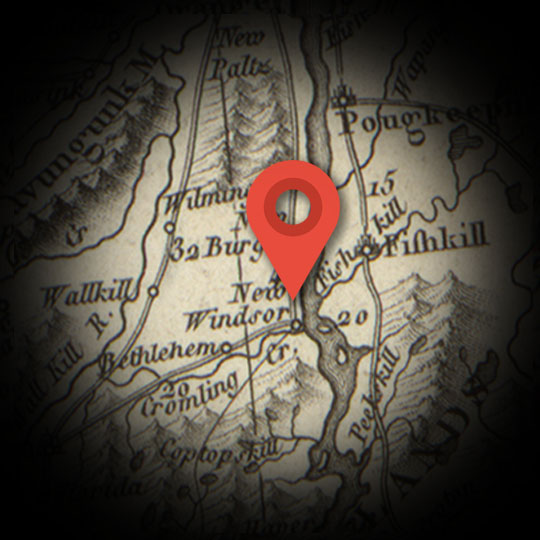NEW WINDSOR
Explore
Since he was often plying the corridor between New York City and Albany during his life time, it should come as no surprise that Alexander Hamilton would have been intermittently present at this small settlement in the Hudson Valley.
But the number of Hamilton’s letters and papers specifically dated from New Windsor are prodigious. There are over fifty pieces of his correspondence in the archives posted from New Windsor between 1777 and 1781, indicating he spent a not inconsiderable portion of his whole Revolutionary War career in this hilly, heavily-wooded spot of Highlands just south of the city of Newburgh, New York.
The British Military had identified the Hudson Valley as a key military target in 1775. British General John Burgoyne saw the region as a critical diving line between New England and New York City, and all the colonies to the South. Indeed, New Windsor had proven itself strategic in 1776 when militia riflemen from Pennsylvania, Maryland, and Virginia had crossed the Hudson River here en route to Boston. Burgoyne, considering this, surmised that if the King’s forces could seize and hold this region, they could keep America divided in two—and preserve an important supply route from friendly territory in Canada.
The British military went on to plan their campaign posing one force traveling south down the valley to meet another coming north out of occupied New York City. New Windsor and places like it therefore became important junctures in the conflict. The decisive win for the American patriots at the Battle of Saratoga, which ended on October 17, 1777, closed this early phase of the war, and clinched the game-changing development of persuading France to join the Americans’ side.
But the Hudson Valley had to remain protected so Burgoyne’s strategy couldn’t be employed a second time. It was also a convenient redoubt at which to observe British-occupied New York City, which George Washington dreamed of retaking. These facts contributed to George Washington making New Windsor his headquarters both for one period in June, 1779, and for another, longer period two years later. He designated New Windsor as his army’s winter quarters from the fall of 1780 to the summer of 1781. New Windsor additionally was the birthplace of George Clinton, an influential patriot, member of the Continental Congress, and wartime governor of New York. (Clinton would, in later years, become a bitter political enemy of Hamilton’s).
Alexander Hamilton’s passing through New Windsor began in the fall of 1777. In mid-November that year, while dispatched on business from Washington, Hamilton had to pause and rest at Windsor for two days. He wrote his commander that he had taken sick with “fever and violent rheumatic pains throughout [his] body.”
During both periods that George Washington used New Windsor as his headquarters, he made the now long-demolished Colonel Thomas Ellison house his command post. It was in this house in February, 1781, that Hamilton had such an angry, verbal altercation on the staircase with the general that Hamilton resigned his position as aide de camp and Washington accepted. Their conflict was subsequently smoothed over, and Hamilton continued to assist Washington in his secretarial and various other duties for a month or so after.
While the argument might have seemed superficially motivated, most scholars and biographers accept that Hamilton had long been brimming with resentment at Washington for refusing to promote him into a more active role in the war; something Washington felt he could not do since Hamilton’s service was so valuable to him.
In the aftermath of his split with Washington, Hamilton and his wife took lodgings at De Peyster’s Point, on the river just across from New Windsor, from mid April until late May of 1781, when they both returned to the Schuyler Mansion in Albany.
Hamilton at this time still occasionally assisted Washington, while in the meantime scheming for a way to secure higher army rank or some other method of accruing battlefield glory to position him for an exalted postwar career. Washington would soon place Hamilton in command of a battalion at the Battle of Yorktown, in Virginia, thus granting his ambitious aide exactly the opportunity he sought.

TIME FRAME:
1777-1781
